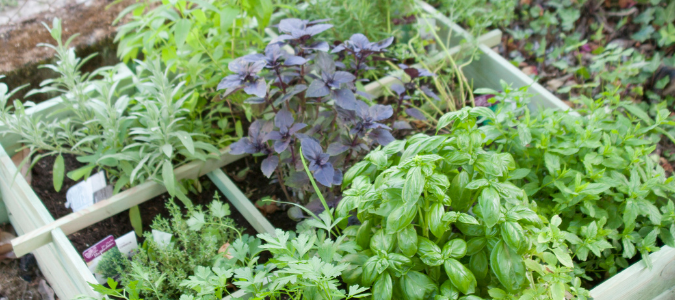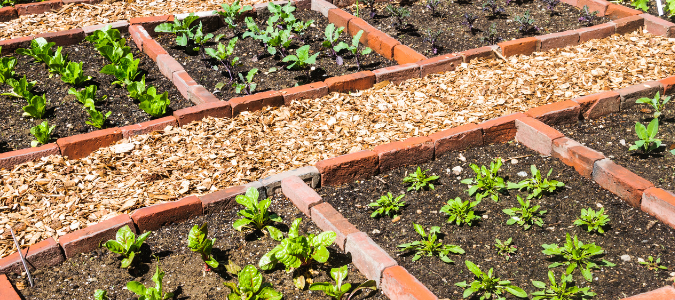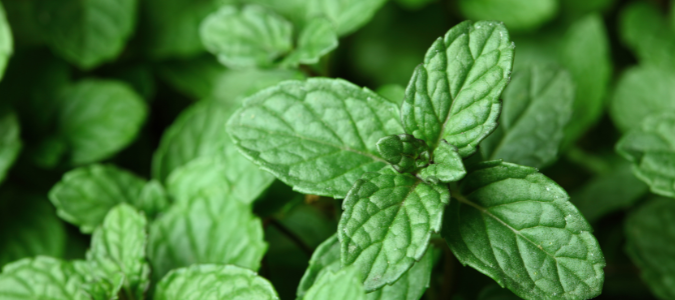An herb garden makes a beautiful, fragrant and useful addition to any yard. If you don’t know how to start an herb garden, it can seem like a daunting task. But starting an herb garden is actually a perfect project for beginner gardeners. There are many herbs that are very easy to grow and care for. You can use them in cooking, making delicious drinks or even in homemade flower arrangements. Here are the basics of starting an herb garden, to get you started on your gardening journey.
To start your herb garden, you’ll need just a few basic things: a space for the garden, sunlight, soil that is good for growing herbs and seeds or starter plants. Yes, it really can be as simple as that!
You can grow herbs right in the ground, or in an existing garden bed. Whether you’re building a new herb garden or using an existing bed, you’ll need to prepare the soil first. Dig it up, turn it over and take out any big rocks. Then mix in some compost to enrich the soil and make sure it has plenty of nutrients for your garden.
Many people also like growing herbs in raised garden beds. To create a raised bed, you can use a galvanized steel container or build one out of two-by-six-inch boards. You can also use regular flower pots of any size.
One benefit to growing herbs in smaller containers is that you can easily move them indoors if it gets too cold or too hot outside. Flower pots and galvanized steel containers both come in varying sizes, from very small to very large. The smaller ones are great for herbs that you’ll leave outdoors when it’s warm and sunny, and then move inside when the weather isn’t right for your herbs.
If you use a metal container, be sure to drill holes in the bottom. That way, it can drain properly after rainfall or watering. If you don’t make holes for drainage, your herbs might get too soggy. This will damage their roots and make it hard for them to thrive.
Wherever you choose to set up your herb garden, it should be in an area that receives full sun, or at least partial sun. Most herbs originated in the Mediterranean region, so they thrive in similar conditions. This means moderate to warm temperatures and plenty of sunlight.
Once you have the right space and container set up for planting your herbs, you’ll need to add soil. You can use a potting mix from your local gardening or home improvement store, but most herbs like soil with good drainage. They do well with loamy soil that doesn’t get too water-logged. If you use topsoil or potting soil, it’s a good idea to add equal parts of sand and compost to the mix.
Now that you have a good, sunny spot and well-draining soil, it’s time to plant the herbs themselves. It’s easiest to begin with starter plants—small, young herbs that have already sprouted. You can get these at a specialty gardening shop, and can often find organic varieties. You can also find them at your local garden center or even at the grocery store. Just know that these may not be the best quality plants.
Rosemary, mint, basil and oregano are very popular herbs with lots of uses. These are all great choices for an herb garden. Plant them about 12 inches apart, so they will have plenty of space to grow. Mint grows quickly and travels far, so it should be planted even farther apart—more like 18 inches away from other plants. Better yet, plant mint in its own container to prevent it from taking over. If you’re using smaller containers, you can plant just one or two herbs per pot, depending on the size.
Basil sometimes needs support as it grows taller. Small metal grow cages are great for this purpose. Other herbs don’t need support. Mint and oregano grow close to the ground, and rosemary grows into a hardy bush with strong, woody stems. Cilantro and dill also grow well without support.
Another great way to start an herb garden is to start seeds indoors and then transplant them a month or two later to an outdoor garden. Basil and oregano often do well when started from seeds. These herbs are great for pasta sauces and soups. Dill and cilantro are also easy to grow from seeds, and make wonderful additions to salads, salsas, soups or fish.
Another nice thing about starting herbs from seeds is that you can do it at any time of year. Once they sprout and start growing, you can transplant them into a container that sits in a sunny kitchen window. That way, you can have fresh herbs ready in any season.
Herbs truly are a great way to get into gardening because they are so easy to grow. They don’t need much in the way of fertilizer. Certain herbs like rosemary, sage and oregano don’t even need a whole lot of water. Mint and basil do well with a regular soaking, as long as the soil is able to drain completely.
Though herbs are easy to grow, the easiest way to have a thriving herb garden is to contact a gardening professional. A pro can get your garden started for you, and then provide you tips on keeping it healthy throughout the seasons. A lawn service pro can also schedule follow-up visits to water, pull weeds, refresh the soil or apply fertilizer and even keep your lawn healthy.
When to Fertilize Your Garden
Knowing when to fertilize your garden is an important aspect of helping it thrive. If you have an herb garden, it may not need regular applications of fertilizer, unless you’re growing the herbs in containers. Other types of gardens, including gardens with flowers, plants, shrubs or fruit trees, can benefit from fertilizer. It all depends on your soil, your regional weather patterns and the type of garden you have.
Whatever type of garden you have, if you’re growing anything in pots or other containers, the plants will need occasional fertilizing. This is because watering leaches nutrients from the soil, and potted plants need to be watered more often than those growing in the ground since they dry out faster.
To make your garden the healthiest, it’s important to know the different types of fertilizer, and when to use them. When you first plant a garden, it’s a good idea to mix some organic fertilizer right into the soil blend. Once the plants are growing, you can follow up with a liquid variety of fertilizer. This can be done whenever the plants start looking as if their colors are fading. Fish emulsion is a good choice for liquid fertilizer applications.
If you are growing herbs, keep in mind that less is more when it comes to fertilizer. Using fertilizer on an herb garden can help them grow more vigorously, but it will also make them taste and smell less strongly. Since their scents and flavors are the best things about herbs, it’s best to use less fertilizer. You can dilute fertilizer to use half the recommended amount on your herbs.
It’s not a good idea to fertilize too late in the growing season. Fertilizer helps plants grow more vigorously. As summer ends and fall begins, we want plants to slow down in their growth, not speed up. Letting them transition naturally into their dormant phase will help plants prepare for the colder winter season.
It can be confusing to figure out when to fertilize your garden, not to mention how much and what type of fertilizer to use. Hiring professional gardening help is a great way to have the garden of your dreams without the headache of caring for it yourself. It can be tough to keep up with the many details of what your garden needs to thrive and when. A professional can take care of every aspect of garden design, installation and maintenance. They can also refer you to a professional who can take care of your lawn. That way, you can simply relax and enjoy your beautiful outdoor space.
Herb Garden Tips
Starting an herb garden isn’t hard, but it’s good to know some helpful herb garden tips so you can give your new plants their best chance to thrive. Here are some ideas to keep in mind when planning and planting your garden. These will help you keep your gardening experience fun, easy and successful.
- Start with seedlings, not seeds. One tip for beginning herb gardeners is to buy young herb plants instead of trying to start your garden from seeds. You can get seedlings from your local garden store, transplant them into your herb garden at home and watch them grow quickly.
- Wait until the weather is truly warm before planting. Herbs are very sensitive to frost. Waiting until it’s reliably warm out, including at night, will ensure that you plant your herb garden at the right time.
- Use well-draining soil. On that note, another herb garden tip is to use the right soil. Simple potting soil from a bag won’t provide the drainage that most herbs need. You can mix in equal parts of sand and compost to create a well-draining soil mix that is full of the nutrients herbs need.
- Make sure you plant your herbs in a sunny spot. Herbs love sun! Full sun is best, or as close to full sun as your yard provides. At least six hours of sunlight each day is optimal for most types of herbs.
- Clip and use your herbs often. Most herbs grow quickly. They’ll grow even more quickly if you clip them back often. Your cooking will also benefit from frequent pruning of your delicious herbs!
Remember that the best and easiest way to grow a healthy, thriving herb garden is to hire professional help. A landscaping professional can design your garden and install it. They can then keep up with regular waterings, fertilizer applications and whatever else might be needed to keep your garden growing beautifully.
ABC Can Help With Your Garden
At ABC Home & Commercial Services, we understand that homeowners want to be able to enjoy their outdoor spaces. That’s why at ABC, we provide top-notch lawn services so that you can enjoy all your yard and lawn has to offer. Let ABC tackle some of your to-do list so you can start a vegetable garden or spend more time enjoying your home’s outdoor spaces.


